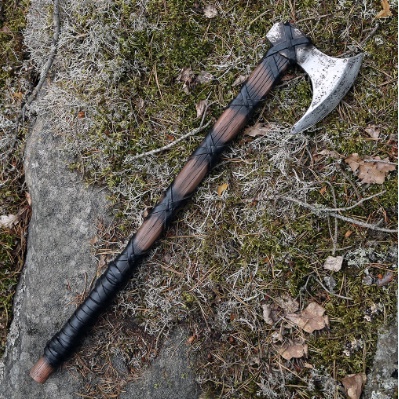Axes, fundamental tools with a rich history, have been crafted and wielded by diverse cultures throughout the ages. In this article, we delve into the unique characteristics of Viking axes and American axes, exploring the craftsmanship, functionality, and cultural significance embedded in each.
Viking Axes:
- Design and Functionality: Viking axes, renowned for their distinct design, typically feature a broad, bearded blade with a sharp edge and a pronounced wedge shape. These axes served dual purposes as both tools for everyday tasks and formidable weapons on the battlefield. The elongated handle allowed for versatile one-handed or two-handed use, providing Vikings with adaptability in various situations.
- Cultural Significance: The Viking axe holds deep cultural significance within Norse history, symbolizing the prowess and martial spirit of the Viking warrior. Beyond its utilitarian purposes, the axe was a status symbol, often adorned with intricate carvings and reflecting the craftsmanship of the Norse people.
- Versatility: Viking axes were versatile tools, indispensable for activities such as woodworking, hunting, and shipbuilding. This multifunctionality showcased the practical nature of Norse craftsmanship.
American Axes:
- Traditional American Designs: American axes, shaped by the diverse cultures and needs of Native American tribes and later European settlers, come in various designs. The Hudson Bay axe, for example, features a compact head with a thin blade, ideal for light chopping and forestry work. Other styles, such as the Kentucky or Michigan pattern axes, are suited for heavier tasks like felling trees.
- Pioneer Heritage: American axes played a crucial role in the westward expansion and the pioneering spirit of early settlers. These tools were indispensable for clearing land, building homes, and establishing communities in the vast and untamed wilderness of North America.
- Craftsmanship in America: Throughout American history, skilled blacksmiths and axe makers contributed to the development of axes suited for the specific needs of different regions and industries. The craftsmanship of American axes reflected the practical demands of the time.
Comparison:
- Blade Shape and Purpose: While both Viking and American axes share a utilitarian origin, Viking axes typically have a broader, more wedge-shaped blade designed for cutting and slashing, while American axes exhibit a range of blade shapes catering to specific tasks, from felling trees to shaping wood.
- Cultural Heritage: The Norse axe carries a symbolic weight deeply embedded in Norse culture, representing martial prowess and the Viking way of life. American axes, on the other hand, embody the pioneering spirit and resilience of early settlers in North America, forging a connection to the continent's frontier history.
- Versatility vs. Specialization: Viking axes were prized for their versatility, seamlessly transitioning between tool and weapon. American axes, with their diverse designs, often leaned towards specialization, with different patterns crafted for specific tasks.
In comparing Viking axes and American axes, we uncover not only the functional disparities but also the cultural and historical narratives woven into each. Both axe traditions, whether wielded by Norse warriors or American pioneers, reflect the ingenuity and resourcefulness of their respective cultures, leaving an enduring impact on the tools we still use today.


No comments yet